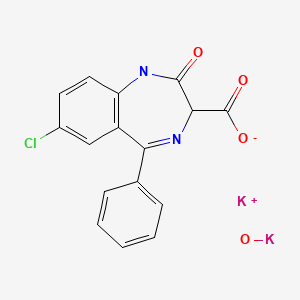CASRN: 57109-90-7

Drug Levels and Effects
Summary of Use during Lactation
Clorazepate is excreted into breastmilk and appears to accumulate in the serum of breastfed infants. Because the half-life of clorazepate and its active metabolite are long, timing breastfeeding with respect to the dose is of little or no benefit in reducing infant exposure. Other agents may be preferred, especially while nursing a newborn or preterm infant. If clorazepate is used, monitor the infant for sedation, poor feeding and poor weight gain.
Drug Levels
Clorazepate is a prodrug of nordiazepam (desmethyldiazepam) which is the primary active metabolite of diazepam.
Maternal Levels. After a single 20 mg intramuscular dose of clorazepate in 7 women, milk nordiazepam levels ranged from 7.5 to 15.5 mcg/L at 2 days after the dose and 6 to 12 mcg/L at 4 days after the dose.[1]
Infant Levels. Nordiazepam has been found in infants' serum in levels higher than milk levels, indicating accumulation, and only slightly lower than adult therapeutic levels after diazepam use by the mother.[2,3]
After a single 20 mg intramuscular dose of clorazepate in 7 women, serum levels of their breastfed infants ranged from trace levels in 5 of the infants to 4 and 7.5 mcg/L in the others on the second day after the dose. On the fourth day after the dose, infant serum levels was a trace amounts in one and ranged from 4 to 8.5 mcg/L in the others, indicating accumulation in infant serum.[1]
Effects in Breastfed Infants
Sedation in infants has been reported during maternal use of diazepam which has nordiazepam as its active metabolite.[3,4] Concern has also been expressed that nordiazepam may compete with bilirubin for hepatic glucuronide conjugation in the neonate.[2]
Effects on Lactation and Breastmilk
Relevant published information was not found as of the revision date.
Alternate Drugs to Consider
(Anxiety) Lorazepam, Oxazepam, Temazepam (Seizure Disorder) Carbamazepine, Divalproex, Gabapentin, Lamotrigine, Oxcarbazepine, Phenytoin, Valproic Acid
References
- 1.
- Rey E, Giraux P, d'Athis P, et al. Pharmacokinetics of the placental transfer and distribution of clorazepate and its metabolite nordiazepam into the feto-placental unit and in the neonate. Eur J Clin Pharmacol 1979;15:181-5. [PubMed: 37090]
- 2.
- Erkkola R, Kanto J. Diazepam and breast-feeding. Lancet 1972;299:1235-6. [PubMed: 4113217]
- 3.
- Wesson DR, Camber S, Harkey M, Smith DE. Diazepam and desmethyldiazepam in breast milk. J Psychoactive Drugs 1985;17:55-6. [PubMed: 3920372]
- 4.
- Patrick MJ, Tilstone WJ, Reavey P. Diazepam and breast-feeding. Lancet 1972;299:542-3. [PubMed: 4110044]
Substance Identification
Substance Name
Clorazepate
CAS Registry Number
57109-90-7
Drug Class
Breast Feeding
Lactation
Milk, Human
Hypnotics and Sedatives
Anti-Anxiety Agents
Benzodiazepines
Disclaimer: Information presented in this database is not meant as a substitute for professional judgment. You should consult your healthcare provider for breastfeeding advice related to your particular situation. The U.S. government does not warrant or assume any liability or responsibility for the accuracy or completeness of the information on this Site.
Publication Details
Publication History
Last Revision: January 15, 2024.
Copyright
Attribution Statement: LactMed is a registered trademark of the U.S. Department of Health and Human Services.
Publisher
National Institute of Child Health and Human Development, Bethesda (MD)
NLM Citation
Drugs and Lactation Database (LactMed®) [Internet]. Bethesda (MD): National Institute of Child Health and Human Development; 2006-. Clorazepate. [Updated 2024 Jan 15].